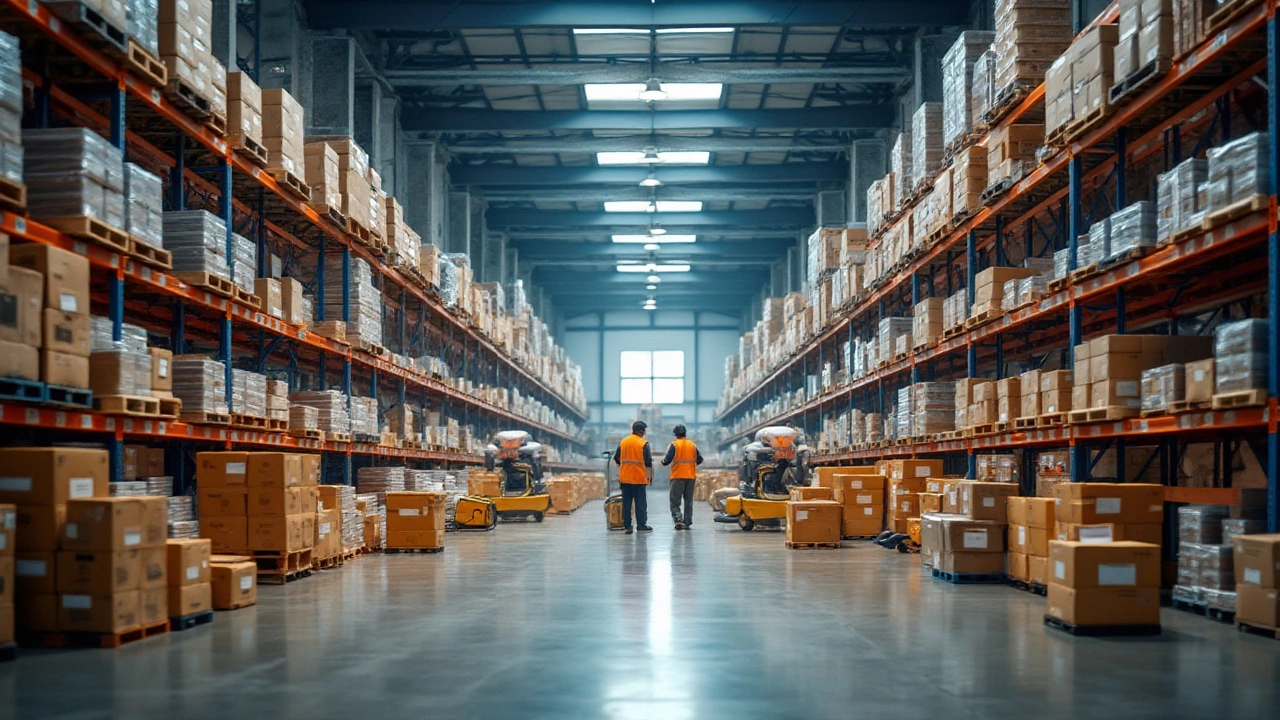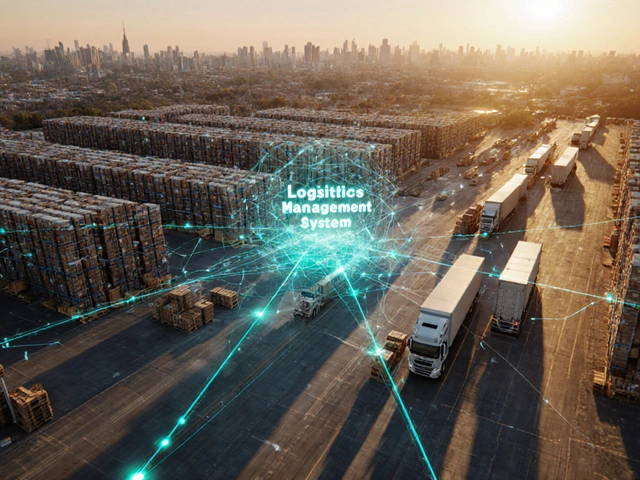In a world refined by the art of movement, logistics stands as the heartbeat of commerce, ensuring that things arrive where they should, right on cue. But what exactly does logistics mean in its simplest form? Imagine it as the great orchestrator—responsible for managing how goods flow from one place to another, seamlessly.
Stripped down to its core, logistics is all about ensuring that products reach customers with precision and efficiency. Though it might seem straightforward, the journey involves a symphony of complex processes and platforms. From the inception of an order to its delivery, every step is a deliberate and calculated action driven by logistics.
In this article, we will untangle the intricacies of logistics, explore the pivotal role of technology, and provide practical advice for navigating this ever-evolving field. By doing so, you'll gain a comprehensive understanding of logistics and its indispensable role in today's fast-paced world.
- Defining Logistics: More Than Just Transportation
- The Role of Technology in Modern Logistics
- Challenges Faced by Logistics Companies
- Tips for Efficient Logistics Management
- The Future of Logistics and Emerging Trends
Defining Logistics: More Than Just Transportation
When most people think of logistics, they often picture trucks, ships, and cargo planes tirelessly moving goods from one point to another. But logistics encapsulates much more than mere transportation; it is the invisible framework that supports entire economies. At its core, logistics involves a detailed planning process to ensure that the right products are delivered to the right place at the right time, and in the right condition. Logistics, as an integral part of supply chain management, is about coordinating all these movements effectively and efficiently.
Let's break it down further: logistics begins from the moment a product is created and involves a series of steps including demand forecasting, procurement of raw materials, production processes, inventory management, and eventually, the transportation of finished goods to retailers or directly to customers. Each of these stages needs to work in harmony to prevent bottlenecks or delays, making efficient logistics critical for business success. Logistics professionals meticulously synchronize these components, ensuring a seamless flow of information and products. This coordination is what sets apart stellar logistics operations from ordinary ones.
At the heart of logistics lies technology, reshaping how the industry operates globally. Innovations like RFID tags, Internet of Things (IoT) devices, and advanced analytics have transformed traditional logistics methods. These technologies facilitate real-time tracking, enhance inventory management, and improve delivery times. According to the Bureau of Transportation Statistics, in the United States alone, businesses spend billions on logistics annually, underscoring its significance in economic functioning. The ability to manage complex distribution networks effectively can make companies stand out in competitive markets.
A celebrated logistics expert once said, "Logistics is the ballasting of the economy." This statement rings particularly true when one considers the ripple effect logistics has on pricing, availability of goods, and ultimately, consumer satisfaction. It's not just about transporting items; it's about creating a strategic advantage.
The detailed orchestration involved in logistics means companies must constantly adapt to changing market trends and consumer expectations. Companies often invest heavily in optimizing their logistics processes, seeking faster delivery routes, sustainable practices, and advanced planning solutions to meet the growing demands. By aligning logistics strategies with business objectives, organizations can achieve remarkable efficiencies and cost savings, leading to enhanced profits and better customer service.
The Role of Technology in Modern Logistics
The landscape of logistics has transformed immensely with the advent of technology, almost reinventing how we perceive and execute the logistics processes. From the basics of tracking and tracing to sophisticated systems that predict supply chain risks, technological advancements have had a profound impact. Imagine a logistics ecosystem where everything from warehouses to delivery vehicles is interconnected, providing real-time data that helps companies make informed decisions. This integration uses systems such as Warehouse Management Systems (WMS) and Transport Management Systems (TMS), which facilitate more streamlined and efficient operations. These technologies allow businesses to forecast demand changes, reducing waste and enhancing productivity. It's fascinating how they not only cut costs but also improve customer satisfaction by offering transparency and reliability.
Perhaps one of the standout developments in this sector is the Internet of Things (IoT). IoT enables devices to communicate with each other over internet networks, drastically changing the dynamics of how goods are tracked and managed in real-time. Sensors installed in storage facilities and delivery vehicles relay data that ensures temperature-sensitive products like pharmaceuticals and food items are maintained under optimal conditions throughout their journey. This visibility diverts potential losses and eliminates bottlenecks. Another aspect is the use of Artificial Intelligence (AI) and machine learning algorithms. By analyzing massive data sets, AI systems optimize route planning and fleet management, ensuring quicker deliveries while minimizing fuel consumption. This not only delivers economic benefits but also contributes to environmental sustainability.
The rise of autonomous vehicles could be considered a game-changer for professionals in supply chain management. Self-driving trucks and drones bring unprecedented efficiency, as they can operate without breaks, potentially revolutionizing last-mile delivery, especially in urban settings. The significance of robotics cannot be ignored either, as smart robots within warehouses efficiently handle sorting, packing, and even shelving tasks, reducing human error and labor costs. Beyond gadgets and machines, blockchain technology is gaining traction. Its decentralized ledger system secures transactions, guaranteeing the authenticity and integrity of goods being supplied without the need for intermediaries, cutting down time and costs related to verification processes.
While these advancements indicate a promising future, it's essential to recognize the challenges that accompany them. The investment cost of acquiring and maintaining these technologies can be daunting for smaller distribution firms. Moreover, cybersecurity threats pose significant risks, as sensitive data can become targets for malicious actors. Despite these hurdles, the relentless pace of change and adaptation in the logistics sector remains ever-positive. According to a statement by Tim Cross, Chief Technology Officer at Advanced Logistics Inc., "The synergy between technology and logistics signifies more than mere efficiency improvements – it's about reshaping the supply chain to be more resilient and adaptive."
"The synergy between technology and logistics signifies more than mere efficiency improvements – it's about reshaping the supply chain to be more resilient and adaptive." - Tim Cross, Chief Technology Officer at Advanced Logistics Inc.

Challenges Faced by Logistics Companies
The world of logistics is a robust mixture of fast-paced hurdles and intricate puzzles. Logistics companies continually find themselves grappling with unique and demanding challenges. One significant hurdle is handling the complexities of global transportation networks. With borders constantly shifting under political and economic pressures, logistics firms must stay nimble. They adapt, reroute, and readjust plans at the drop of a hat. Whether it’s dealing with an unexpected tariff or a shipping delay, the ability to forecast and circumvent disruptions is pivotal.
The ever-evolving nature of technology presents both an opportunity and a challenge. With innovations like IoT and AI, logistics companies are driven to integrate cutting-edge solutions into their systems. While these technologies promise efficiency and accuracy, the transition is not always smooth. Companies face high costs, the need for skilled workforce training, and ensuring cybersecurity. As a logistics manager once said,
"Technology is our greatest ally yet sometimes our fiercest obstacle."This reality underscores the dual-edged impact that tech advancements bring to the logistics sector.
Additionally, the rising demand for sustainability has put tremendous pressure on logistics operations. Consumers and governments alike are pushing for greener practices, requiring logistics firms to rethink their supply chain strategies. Switching to sustainable practices often involves significant investment and restructuring, which can be daunting for traditional logistics companies. Despite these challenges, the demand for eco-friendly solutions has led to innovative practices, such as the use of electric vehicles and alternative fuel sources, contributing to a more sustainable future.
Employee retention and labor shortages add another layer of complexity to logistics operations. Attracting and keeping skilled workers is crucial for maintaining seamless workflows. The industry typically requires long hours and complex problem-solving, which can lead to high turnover rates. Implementing strategies for a supportive work environment and fostering career growth are essential for addressing this workforce issue. Turning the tide on this challenge requires deep understanding of employee needs and offering competitive incentives to ensure that talent remains within the company.
Logistics companies also encounter the intricacies of inventory management. Finding that sweet spot — where supply meets demand without overstocking or understocking — requires precision and constant monitoring. Technology plays a critical role here, offering data-driven insights. However, unexpected economic shifts or sudden changes in consumer behavior can disrupt even the best-laid plans. Firms must cultivate flexibility and quick-response strategies to adjust their inventory levels dynamically and efficiently.
Tips for Efficient Logistics Management
Efficient logistics management is crucial for businesses aiming to maintain a competitive edge in today's fast-paced market. It encompasses the optimization of various elements such as distribution networks, inventory control, and communication channels, all of which are fundamental to a smooth-running operation. A primary step in achieving this efficiency is understanding the intricacies of your entire supply chain. Mapping the complete journey of products from suppliers to end-users can significantly improve logistics workflows and reveal opportunities for enhanced efficiency. Engaging in regular reviews and analysis of logistics operations enables companies to stay updated on the best practices and emerging trends in the industry.
One actionable tip for better logistics management is investing in reliable software solutions. Technological solutions, such as warehouse management systems (WMS) and transportation management systems (TMS), streamline complex processes and offer real-time data tracking. A report by Gartner suggests that companies leveraging TMS can see transport cost reductions by up to 8%, evidencing the financial perks of technological investment. Additionally, utilizing integrated systems not only aids in cost reduction but also facilitates smoother communication between different departments, ensuring that everyone is on the same page and can react quickly to any disruptions. This investment is vital in optimizing transportation and supply chain management.
Another critical strategy involves building strong partnerships with logistics companies. Collaboration can significantly impact delivery speeds and reliability, playing a critical role in meeting consumer expectations. Sourcing partners who align with your values and service goals can be a game-changer. Moreover, long-term partnerships often result in better service terms and mutual benefits over time. According to McKinsey & Company, aligning closely with your logistics partners can lead to improved communication and productivity, bolstering the efficiency of the entire chain.
- Keep buffers in inventory to accommodate unforeseen demands and delays.
- Design flexible routes that can quickly adapt to changes in demand or supply chain disruptions.
- Continuously train your workforce on new technologies and methodologies.
- Measure KPIs consistently to track the performance of logistics operations.
- Develop contingency strategies for potential supply chain interruptions.
While often overlooked, employee engagement is an underrated aspect of logistics management. When employees feel valued and are well-trained in the latest software and processes, productivity naturally increases. Continuous training sessions and empowerment initiatives should be part of the logistics management framework. Engaging employees not only enhances their performance but also minimizes errors that can lead to costly rectifications. A recent study by Deloitte highlights that organizations with high employee engagement are 21% more profitable, further emphasizing its importance.
Ultimately, effective logistics management requires a blend of technology, partnerships, and human management. By focusing on these key elements, companies can boost their operational efficiency and deliver consistently outstanding service. As technology evolves and customer demand becomes ever more complex, staying ahead of logistical trends and adapting to changes swiftly is not just beneficial—it is essential for thriving in the marketplace.

The Future of Logistics and Emerging Trends
The logistics landscape is undergoing a remarkable transformation, driven by technological advancements and shifting consumer expectations. As businesses race towards greater efficiency, the integration of artificial intelligence (AI) and machine learning is playing a pivotal role. These technologies are revolutionizing logistics by optimizing routes, forecasting demand, and even managing inventory in real-time. With AI, logistics companies can minimize fuel consumption and reduce delays, ensuring that goods reach their destination faster and at a lower cost.
Another significant trend is the rise of autonomous vehicles and drones. While they might sound like something from a sci-fi movie, these innovations are starting to make significant impacts. Autonomous trucks can operate around the clock without rest, revolutionizing transportation. Meanwhile, drones facilitate rapid delivery, especially in remote or hard-to-reach areas, where traditional methods falter. Corporations are investing heavily in these technologies, predicting that they will soon become standard in logistics operations.
The emphasis on sustainability is reshaping how logistics companies operate. Consumers increasingly demand that businesses take responsibility for their environmental impact, spurring investment in greener modes of transportation and more eco-friendly packaging solutions. For instance, electric delivery trucks are gaining popularity, drastically cutting emissions compared to their diesel counterparts. One notable leader in this trend stated,
"We have a duty to ensure the logistics of tomorrow are not only faster and more efficient, but also greener,"underscoring the industry's commitment to environmental stewardship.
An emerging trend is the use of blockchain technology to enhance transparency and security in the supply chain. With the ability to provide a tamper-proof record of every transaction, from the manufacturer to the end customer, blockchain is creating trust among businesses and consumers alike. This ensures that all stakeholders have access to pertinent data, thus enhancing the accuracy of information throughout the supply chain.
The future of logistics also hinges on data-centric strategies that provide insights based on consumer behavior. As companies strive to predict trends and demands, data analytics tools are becoming indispensable. This shift towards being information-driven ensures a more tailored service that meets consumer needs with precision. In fact, many logistics giants are now employing intricate predictive models to stay ahead of demand fluctuations, ensuring that goods are available when and where they're needed.





